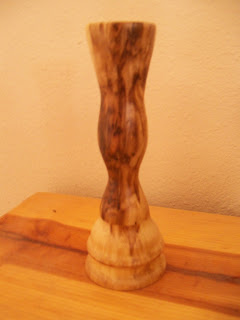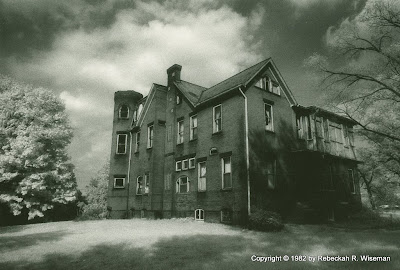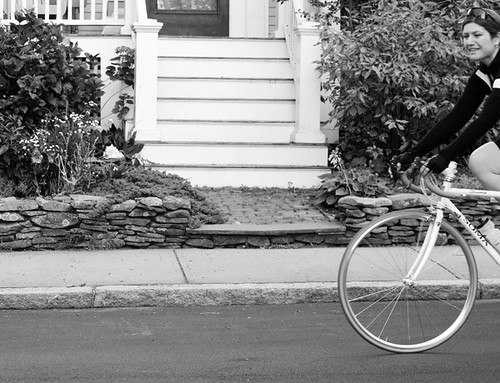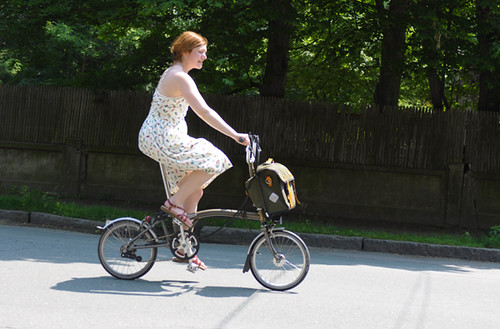Eliza is presumed to be the daughter of James and Sophia (Hazlett) Dunfee. The primary link is the fact that Eliza was living with Jonathan Haslett in Mifflin Twp, Ashland County, Ohio in 1850. We're making the assumption that Jonathan is probably the father of Sophia. Bottom line is that I really don't have any “proof” that Eliza is the daughter of James and Sophia.
Census records put the year of birth for Eliza Dunfee at 1811, 1813, or 1815 and place of birth in Maryland or Pennsylvania. In 1850, she is 39 years old and born in Maryland. In 1860 she is 47 and born in Pennsylvania. And in 1870 she is 55 and born in Pennsylvania. Chances are, her age in 1850 is probably closer to the truth ;-) since she seems to lose a few years with each census.
Eliza married Aquilla Hoff on September 4, 1851 in Ashland County, Ohio as recorded in volume 2, page 70 (license 1134) of Ashland County Marriage Records.

The image above is from the FamilySearch online database of Ohio County Marriages. There seems to be some “confusion” on the part of the clerk that recorded the marriage or the “authority” who performed the ceremony. Under “Names of Parties” it shows that the record is for Aquilla Hoff and Eliza Dunfee. In the far right column, it states that R. D. Emerson is certifying that “on the 4th day of September Eighteen hundred and fifty one I joined in Marriage Mr. George W. Brown and Miss Eliza Dunfee.”
In actuality, it was Eliza Dunfee who married Aquilla Hoff. When the property of Jonathan Hazlett was sold on October 25, 1853, the majority of the items were sold to Aquila Hoff.

Sale Bill from the estate file (#190) of Jonathan Hazlett. Ashland County, Ohio.

The last entry in the above image (a portion of page 299 of the Ashland County Tract Book) shows that Luke Selby, administrator of the estate of Jonathan Hazlett sold in March 1854 the land that had been owned by Jonathan to Aquilla Hoff. The transaction is also recorded in Ashland County Deed Book 10 page 206.
Aquilla Hoff and his wife Eliza, sold that land to Christian Vesper on March 27, 1857 (Ashland County Deed Book 15 pages 162-163).
That was, essentially, all the information I had on Aquilla and Eliza. Until in November .., when I received an email in response to an 11 year old query I had posted on the Hoff Family Genealogy Forum. My correspondent passed along the information that Aquilla and Eliza had moved to LaGrange County, Indiana where she had found them in the 1860 census.
I'm guessing that they probably moved to LaGrange County in the spring of 1857 after they sold the land that had belonged to Jonathan Hazlett. They are listed in the 1860 and 1870 census in Bloomfield Township, LaGrange County, Indiana.
Aquilla Hoff is 45 years old in 1860. He is a farmer with real estate valued at $3000 and a personal estate of $342. He was born in Maryland. Listed in his household was Eliza, age 47 and born in Pennsylvania; Jonathan, age 6 and born in Ohio. Also included was Lucetta Dumbar, 12 years old and born in Indiana.
In 1870, Aqula Hoff is 54 years old. He is still a farmer but has real estate valued at $5000 and a personal estate of $1000. He was born in Maryland. Included in his household were Eliza, now 55 but still stating she was born in Pennsylvania; and Jonathon, who is 16 years old and born in Ohio.
Eliza (Dunfee) Hoff died on August 6, 1876 and is buried in Greenwood Cemetery, Lagrange County, Indiana. There is a memorial for her on Find A Grave. Looking closely at the photo of her gravestone it appears that the word “AGED” is written below the date of death. If so, it might pinpoint her year of birth a little better than the census records.
In the 1880 census, Aquilla Hoff was found in Drum Creek Township, Montgomery County, Kansas. He was 65 years old, retired and born in Maryland. Listed with Aquilla was his son, Jonathan H. Hoff, who was 26 years old, a farmer, and born in Ohio. He gave his father's place of birth as Maryland and that of his mother as Pennsylvania.
According to my correspondent, Aquilla Hoff was born February 15, 1815 in Washington County, Maryland and died June 27, 1883 in LaGrange County, Indiana. However, I suspected that he died in Kansas since that was where he was living in 1880. Turns out, Aquilla really did die in LaGrange County. There is an entry for him in the book “Indiana Deaths, 1882-1920” that was compiled by the W.P.A. (Works Progress Administration). It shows that he died in Newbury Township and was 68 years old.
What happened to their son Jonathan H. Hoff? Jonathan does not appear to be in the census records after 1880 (ancestry online index).
I did find a John H. Hoff in Kansas census records, 1900 through 1930, that I think is a likely candidate to be Jonathan H. Hoff, son of Aquilla and Eliza. However, there is a six year discrepancy in their ages.
But, this John H. Hoff has a daughter, his first born child, named Eliza... and his middle name is Hazelet!
See The Dunfee Family :: Are Jonathan H. Hoff and John H. Hoff the same man?
See the Index for previous posts on the Dunfee family.




 Here is the updated situation on the road to Paradise, infused with a fresh supply of images for your consumption. As it stands today (Valentines Day) t
Here is the updated situation on the road to Paradise, infused with a fresh supply of images for your consumption. As it stands today (Valentines Day) t In the meantime, here are some pictures for you. This is what happens when the road isn't plowed for a few days during a winter storm. No way would you get into the Paradise Old Station on a day like this. Breaking into the second story window isn't an option! Many old-time climbers may recall that this was where you'd self register for winter trips.
In the meantime, here are some pictures for you. This is what happens when the road isn't plowed for a few days during a winter storm. No way would you get into the Paradise Old Station on a day like this. Breaking into the second story window isn't an option! Many old-time climbers may recall that this was where you'd self register for winter trips.  Getting into the Jackson Visitor Center poses similiar problems.
Getting into the Jackson Visitor Center poses similiar problems. 
 Climbers strive to push the boundary of their sport to new limits every day – faster ascent times (
Climbers strive to push the boundary of their sport to new limits every day – faster ascent times ( According to Nordfors, other than the actual physical conditioning required to complete this sort of endurance event, the two most important aspects of his training was eating when your body didn’t want to, and staying focused and mentally alert while your body is completely exhausted. As a retired competitive bicycle racer, Nordsfors is not new to intense training and challenges. Although only a novice climber, Nordfors, 45, decided that after his retirement from racing a few years ago, he wanted to try new things and test the ability of his body to new limits. His trip from Puget Sound to Summit certainly proved to be a worthy challenge, and although Nordfors achieved both of his lofty goals, he is not completely satisfied with his bicycle ride from Tolmie Park to Paradise and will attempt to improve his time in a another epic tour. Best of luck on your next adventure Randall!
According to Nordfors, other than the actual physical conditioning required to complete this sort of endurance event, the two most important aspects of his training was eating when your body didn’t want to, and staying focused and mentally alert while your body is completely exhausted. As a retired competitive bicycle racer, Nordsfors is not new to intense training and challenges. Although only a novice climber, Nordfors, 45, decided that after his retirement from racing a few years ago, he wanted to try new things and test the ability of his body to new limits. His trip from Puget Sound to Summit certainly proved to be a worthy challenge, and although Nordfors achieved both of his lofty goals, he is not completely satisfied with his bicycle ride from Tolmie Park to Paradise and will attempt to improve his time in a another epic tour. Best of luck on your next adventure Randall!
 It isn't the oldest. It isn't the widest. It isn't the tallest. But a sign proclaims that because of the overall volume of its trunk, the General Sherman Tree is the biggest tree on earth. At its base it measures 103 feet in circumference. It is 275 feet tall. It is approximately 2200 years old. That is one big, old tree! Standing beneath it, gazing up at the high branches, it is difficult to take it all in. And a tiny photograph can't convey how big it really is. It is, quite simply, huge! Almost overwhelming, actually. The people standing beneath the behemoth are dwarfed by its size.
It isn't the oldest. It isn't the widest. It isn't the tallest. But a sign proclaims that because of the overall volume of its trunk, the General Sherman Tree is the biggest tree on earth. At its base it measures 103 feet in circumference. It is 275 feet tall. It is approximately 2200 years old. That is one big, old tree! Standing beneath it, gazing up at the high branches, it is difficult to take it all in. And a tiny photograph can't convey how big it really is. It is, quite simply, huge! Almost overwhelming, actually. The people standing beneath the behemoth are dwarfed by its size. This shows the base of The General Sherman Tree and possibly 25 feet of its height. The lady standing to the left by the fence was about 5'5” tall.
This shows the base of The General Sherman Tree and possibly 25 feet of its height. The lady standing to the left by the fence was about 5'5” tall. The trail to the General Sherman tree continues on as the two-mile loop Congress Trail. Sequoia trees are very shallow rooted and do occasionally topple. The amazing thing to me about this fallen giant is that a small tree has taken root and is growing on the roots of the dead tree. The little one is perhaps four feet tall. I wonder how long it will survive?
The trail to the General Sherman tree continues on as the two-mile loop Congress Trail. Sequoia trees are very shallow rooted and do occasionally topple. The amazing thing to me about this fallen giant is that a small tree has taken root and is growing on the roots of the dead tree. The little one is perhaps four feet tall. I wonder how long it will survive? Another glorious Giant, reaching for the sun... towering over all beneath it.
Another glorious Giant, reaching for the sun... towering over all beneath it.











 The view from the valley floor, midway along the Pa'rus Trail.
The view from the valley floor, midway along the Pa'rus Trail. The peak known as "The Watchman" towers over the Lower Canyon. The Virgin River flows through the canyon and over thousands of years has helped create this marvelous place.
The peak known as "The Watchman" towers over the Lower Canyon. The Virgin River flows through the canyon and over thousands of years has helped create this marvelous place. The wind-whipped water from one of the waterfalls in the Upper Canyon.
The wind-whipped water from one of the waterfalls in the Upper Canyon. A grove of trees in the Upper Canyon area, caught in the fleeting rays of sunshine.
A grove of trees in the Upper Canyon area, caught in the fleeting rays of sunshine. The view from my campsite, near sunset.
The view from my campsite, near sunset.





















